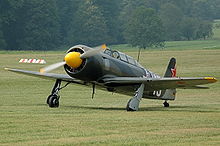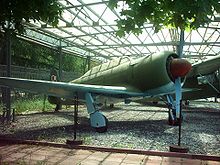Yakovlev Yak-11
| Yakovlev Yak-11 | |
|---|---|
 Jak-11 of the NVA in the airfield museum Cottbus |
|
| Type: | School fighter plane |
| Design country: | |
| Manufacturer: | |
| First flight: |
November 10, 1945 |
| Production time: |
1946 to 1956 |
| Number of pieces: |
3,859 + 707 (license) |
The Jakowlew Jak-11 ( Russian Яковлев Як-11 , NATO code name " Moose ") was a single-engine aircraft from Soviet production. The two - seat low- wing aircraft was specially designed for advanced training of fighter pilots and used in all member states of the Eastern Bloc and the Warsaw Pact as well as in the Middle East ( Egypt , Yemen ), China and Austria . In Czechoslovakia , the type was built in large numbers under license.
development
When designing the Jak-11, which was put on paper from 1944, the designer Alexander Jakowlew oriented himself on the Jak-3 , the last link in the chain of Jak-fighters in World War II . In contrast to the predecessor, an ASch-21 radial engine was provided instead of the V-engines previously used . As with many Soviet aircraft designs of the time, emphasis was placed on simple production and maintenance; there were various detachable fairings and flaps that made it easier to access the engine. The two-bladed adjustable propeller was initially curved into a sickle shape, but was later replaced by the straight 3 m propellers of the type WISch-111-W20 or WISch-11-D-15 .
On November 10, 1945, the first prototype under the name Jak-3UTI took off on its maiden flight and then completed the trial, which lasted about a year, during which some changes were made to the machine. Series production began in 1946/47 and ended in the Soviet Union after 3859 copies were built. In the second half of the 1950s, the Jak-11U (also: Jak-10) appeared as a reaction to the standard configuration of the nose-wheel landing gear on fighter aircraft, also with a nose-wheel.
From 1951 to 1954, the Jak-11 set four international records that were recognized by the FAI .
From 1952 to 1956, 707 Jak-11s were built under license at the Kunovice aircraft plant (Czechoslovakia). They were referred to as Let C-11 (whereby stringers and frames made of wood were partially replaced by metal) and in the case of the nose wheel version C-11U .
In normal flight operations, the Jak-11 was used to train pilots who had already gained some flying experience on the Jak-18 beginner's training aircraft . For shooting tests, the Yak-11 therefore also had a built-in fuselage nose synchronized 12.7 mm machine gun UBS and a photo-MG in the front, occupied by student pilots cabin to check the results. The Jak-11 was used for active training until the late 1950s and was used for secondary tasks until the 1960s. For example, the last four to five of the approximately 100 Yak-11s delivered to the air forces of the NVA in the GDR flew until 1962 in the ZD-21 (target display squadron) as target aircraft for ground defense; the majority had already been separated in 1958/59.
technical description
The Jak-11 was constructed in composite construction. The fuselage consisted of a welded tubular steel frame, which was mostly clad with plywood, only the underside was covered with fabric. The bow was made of metal in the area of the engine mount.
The wing in the low- wing design had two main spars, between which the fuel tanks were located, and was also made of metal. It had an external suspension for a 25 kg or 50 kg bomb on each underside. The landing gear shaft was also equipped with an auxiliary spar made of Dural.
The tail unit was self-supporting and manufactured in a normal construction.
In the stern wheel design, only the main wheels could be retracted, in the nose wheel design the entire landing gear.
Speed and distance records
Class C-1-d (aircraft with a flight weight of 1750-3000 kg)
- 471.348 km / h on a closed 500 km route, established on July 11, 1951 by J. D. Forestenko
- 442.289 km / h on a 1000 km route, set up on August 26, 1951 by N. Golovanov
- 360.032 km / h on a 2000 km route, established on October 31, 1953 by Father Sakhudalin
- 1990.183 km on a straight route, erected on September 11, 1954 by I. Tschernow
Military users

-
 Egypt
Egypt
-
 Afghanistan : 14 from 1958
Afghanistan : 14 from 1958 -
 Albania : 4
Albania : 4 -
 Algeria
Algeria
-
 Bulgaria
Bulgaria
-
 People's Republic of China
People's Republic of China
-
 German Democratic Republic : about 100 from 1953 to 1962
German Democratic Republic : about 100 from 1953 to 1962 -
 Iraq
Iraq
-
 Yemen
Yemen
-
 Mongolia
Mongolia
-
 North Korea
North Korea
-
 Austria : 4 from 1955 to 1965
Austria : 4 from 1955 to 1965 -
 Poland : 101 Jak-11 and 37 C-11
Poland : 101 Jak-11 and 37 C-11 -
 Romania : 90
Romania : 90 -
 Somalia
Somalia
-
 Soviet Union :
Soviet Union :
Technical specifications
| Parameter | Data |
|---|---|
| span | 9.40 m |
| length | 8.50 m |
| height | 3.23 m |
| Wing area | 15.40 m² |
| Empty weight | 1,811 kg |
| Takeoff weight | 2,373 kg to max. 2,480 kg |
| Top speed | 475 km / h at an altitude of 2,250 m |
| Cruising speed | 350-400 km / h |
| Landing speed | 127 km / h |
| Take-off run | 365 m |
| Landing runway | 500 m |
| Service ceiling | 7,100 m |
| Climb performance | 9.0 m / s |
| Range | 1,280 km |
| crew | 1–2 (student pilots / flight instructors) |
| Engine | an air-cooled 7-cylinder radial engine Schwezow ASch-21 |
| Starting power | 515 kW (700 hp) at 2300 rpm |
| Fuel supply | 360 l |
| Armament | one 12.7 mm MG UBS or one 7.7 mm MG SchKAS two 50 kg bombs |
Museum reception
- A Jak-11 of the NVA air force (WNr. 68203) can be viewed in the Military History Museum on the grounds of the Berlin-Gatow airfield .
- Another Jak-11 of the NVA (WNr. 68210) is in the holdings of the Cottbus Airfield Museum on the grounds of the Cottbus Airfield (see photo info box)
- A Jak-11 of the Austrian Armed Forces is on display in the military aviation exhibition Zeltweg in hangar 8 of the Hinterstoisser air base, a branch of the Vienna Museum of Military History .
See also
Web links
Individual evidence
- ↑ Detlef Billig, Manfred Meyer: Aircraft of the GDR Volume 1. TOM Modellbau, Friedland 2001, ISBN 3-613-02197-6 , pp. 90–95
- ↑ Doppeladler.com
- ^ Detlef Billig, Manfred Meyer: Airplanes of the GDR Volume 1. TOM Modellbau, Friedland 2001, ISBN 3-613-02197-6 , p. 180
- ↑ on doppeladler.com , accessed on September 10, 2013


